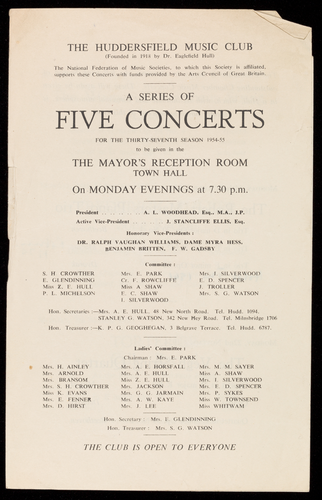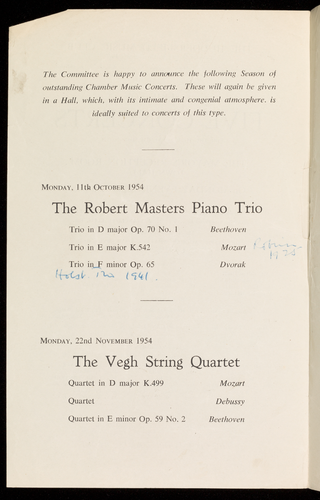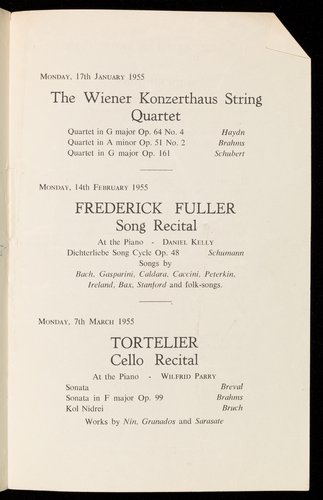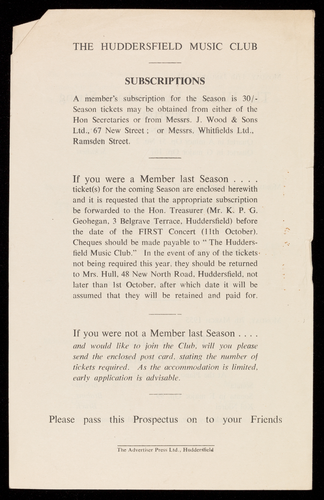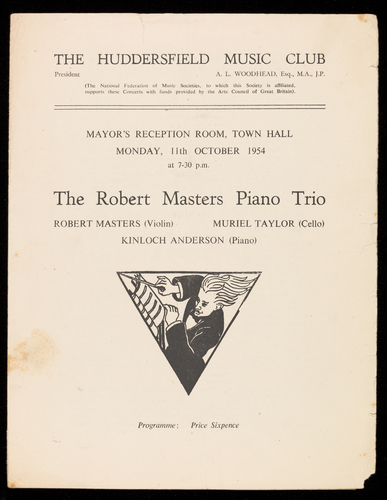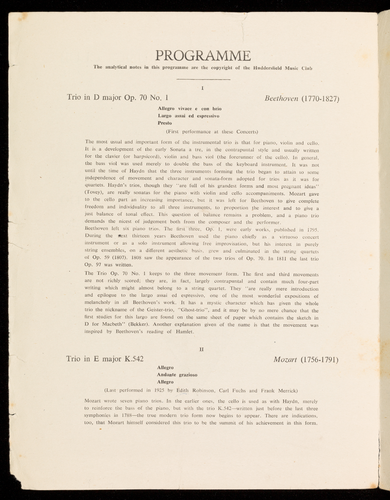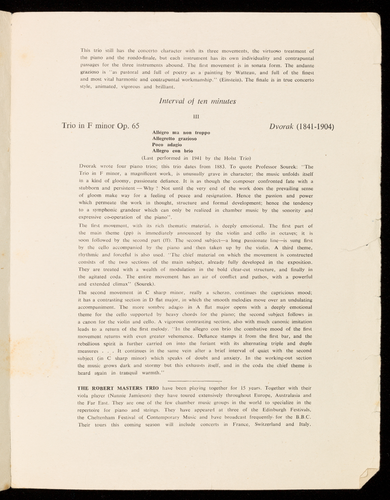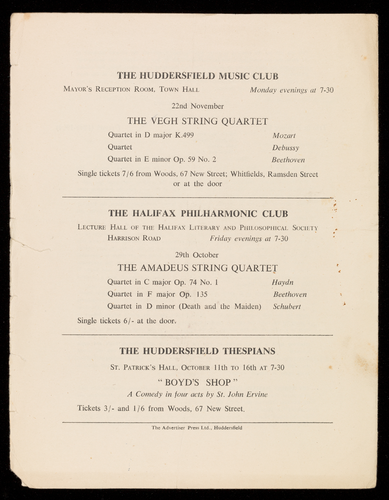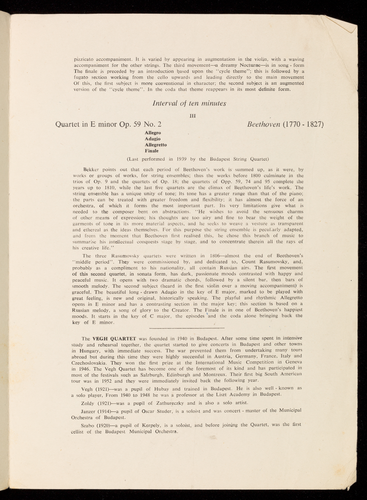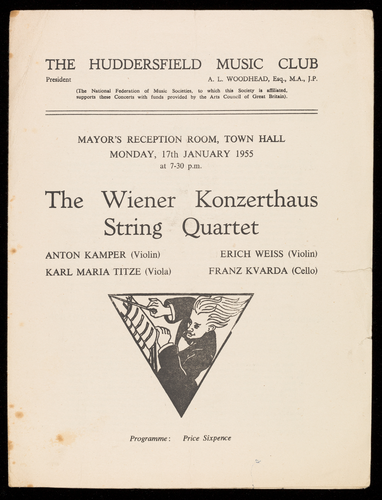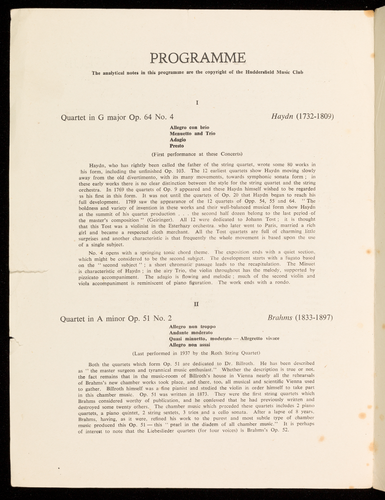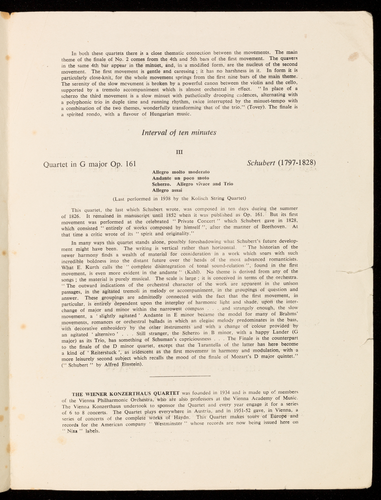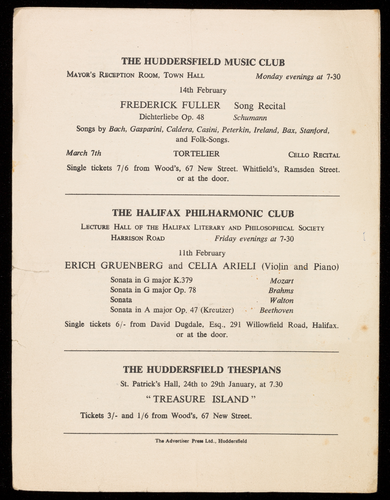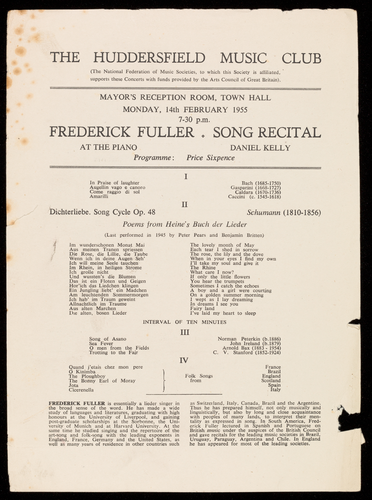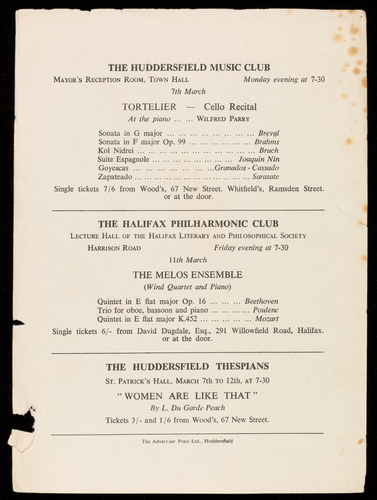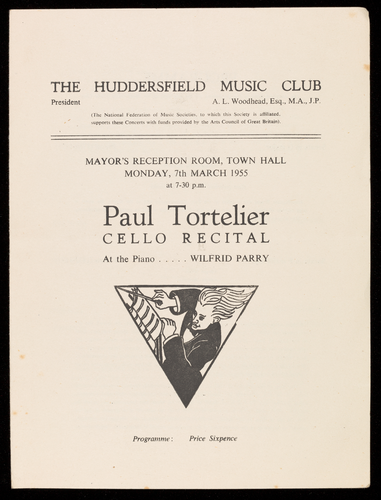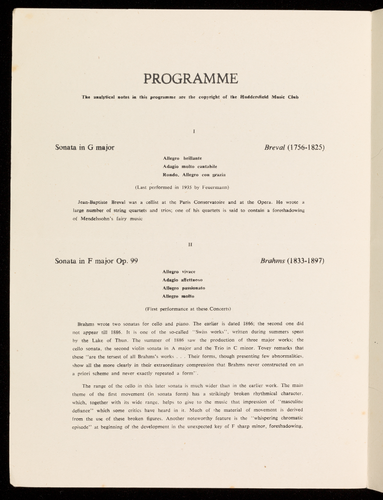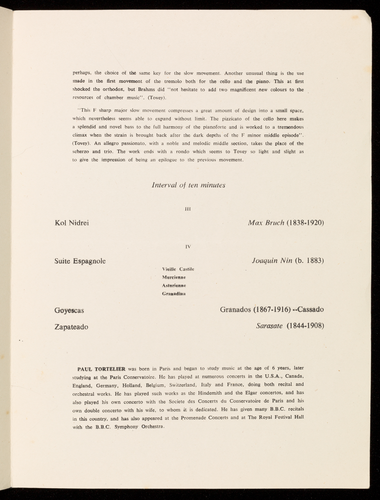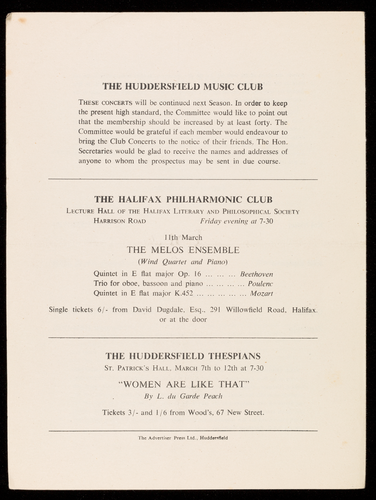Ocr'd Text:
THE HUDDERSFIELD MUSIC CLUB
(Founded in 1913 by Dr. Eaglefield Hull)
The National Federation of Music Societies, to which this Society is affiliated,
supports these Concerts with funds provided by the Arts Council of Great Britain.
A SERIES OF
FIVE CONCERTS
FOR THE THIRTY-SEVENTH SEASON 1954-55
to be given in the
THE MAYOR'S RECEPTION ROOM
TOWN HALL
On MONDAY EVENINGS at 7.30 p.m.
President
Active Vice-President
..
S. H. CROWTHER
E. GLENDINNING
Miss Z. E. HULL
P. L. MICHELSON
..
Honorary Vice-Presidents :
DR. RALPH VAUGHAN WILLIAMS, DAME MYRA HESS,
BENJAMIN BRITTEN, F. W. GADSBY
A. L. WOODHEAD, Esq., M.A., J.P.
J. STANCLIFFE ELLIS, Esq.
Mrs. H. AINLEY
Mrs. ARNOLD
Mrs. BRANSOM
Mrs. S. H. CROWTHER
Miss K. EVANS
Mrs. E. FENNER
Mrs. D. HIRST
Committee:
Mrs. E. PARK
Cr. F. ROWCLIFFE
Miss A SHAW
E. C. SHAW
I. SILVERWOOD
Hon. Secretaries :-Mrs. A. E. HULL, 48 New North Road. Tel. Hudd. 1094.
STANLEY G. WATSON, 342 New Hey Road. Tel. Milnsbridge 1706
Hon. Treasurer -K. P. G. GEOGHEGAN, 3 Belgrave Terrace. Tel. Hudd. 6787.
Ladies' Committee:
Chairman
Mrs. A. E. HORSFALL
Mrs. A. E. HULL
Miss Z. E. HULL
Mrs. JACKSON
Mrs. G. G. JARMAIN
Mrs. A. W. KAYE
Mrs. J. LEE
Mrs. E. PARK
Mrs. I. SILVERWOOD
E. D. SPENCER
J. TROLLER
Mrs. S. G. WATSON
Mrs. M. M. SAYER
Miss A. SHAW
Mrs. I. SILVERWOOD
Mrs. E. D. SPENCER
Mrs. P. SYKES
Miss W. TOWNSEND
Miss WHITWAM
Hon. Secretary: Mrs. E. GLENDINNING
Hon. Treasurer: Mrs. S. G. WATSON
THE CLUB IS OPEN TO EVERYONE
Ocr'd Text:
The Committee is happy to announce the following Season of
outstanding Chamber Music Concerts. These will again be given
in a Hall, which, with its intimate and congenial atmosphere. is
ideally suited to concerts of this type.
MONDAY, 11th OCTOBER 1954
The Robert Masters Piano Trio
Trio in D major Op. 70 No. 1
Trio in E major K.542
Trio in F minor Op. 65
Holst. Th 1941
MONDAY, 22nd NOVEMBER 1954
Beethoven
Mozart Roun
1923
Dvorak
The Vegh String Quartet
Quartet in D major K.499
Quartet
Quartet in E minor Op. 59 No. 2
Mozart
Debussy
Beethoven
Ocr'd Text:
MONDAY, 17th JANUARY 1955
The Wiener Konzerthaus String
Quartet
Quartet in G major Op. 64 No. 4
Quartet in A minor Op. 51 No. 2
Quartet in G major Op. 161
MONDAY, 14th FEBRUARY 1955
FREDERICK FULLER
Song Recital
At the Piano
DANIEL KELLY
Dichterliebe Song Cycle Op. 48
Songs by
Bach, Gasparini, Caldara, Caccini, Peterkin,
Ireland, Bax, Stanford and folk-songs.
MONDAY, 7th MARCH 1955
M
TORTELIER
Cello Recital
At the Piano
Haydn
Brahms
Schubert
Sonata
Sonata in F major Op. 99.
Kol Nidrei
Schumann
WILFRID PARRY
Breval
Brahms
Bruch
Works by Nin, Granados and Sarasate
Ocr'd Text:
THE HUDDERSFIELD MUSIC CLUB
SUBSCRIPTIONS
A member's subscription for the Season is 30/-
Season tickets may be obtained from either of the
Hon Secretaries or from Messrs. J. Wood & Sons
Ltd., 67 New Street; or Messrs. Whitfields Ltd.,
Ramsden Street.
If you were a Member last Season . . ..
ticket(s) for the coming Season are enclosed herewith
and it is requested that the appropriate subscription
be forwarded to the Hon. Treasurer (Mr. K. P. G.
Geohegan, 3 Belgrave Terrace, Huddersfield) before
the date of the FIRST Concert (11th October).
Cheques should be made payable to "The Hudders-
field Music Club." In the event of any of the tickets.
not being required this year, they should be returned
to Mrs. Hull, 48 New North Road, Huddersfield, not
later than 1st October, after which date it will be
assumed that they will be retained and paid for.
If you were not a Member last Season ..
and would like to join the Club, will you please
send the enclosed post card, stating the number of
tickets required. As the accommodation is limited,
early application is advisable.
Please pass this Prospectus on to your Friends
The Advertiser Press Ltd., Huddersfield
$65
Ocr'd Text:
THE HUDDERSFIELD MUSIC CLUB
President
A. L. WOODHEAD, Esq., M.A., J.P.
(The National Federation of Music Societies, to which this Society is affiliated,
supports these Concerts with funds provided by the Arts Council of Great Britain).
MAYOR'S RECEPTION ROOM, TOWN HALL
MONDAY, 11th OCTOBER 1954
at 7-30 p.m.
The Robert Masters Piano Trio
C
ROBERT MASTERS (Violin)
MURIEL TAYLOR (Cello)
KINLOCH ANDERSON (Piano)
Programme:
: Price Sixpence
Ocr'd Text:
PROGRAMME
The analytical notes in this programme are the copyright of the Huddersfield Music Club
Trio in D major Op. 70 No. 1
I
Allegro vivace e con brio
Largo assai ed espressivo
Presto
Trio in E major K.542
(First performance at these Concerts)
The most usual and important form of the instrumental trio is that for piano, violin and cello.
It is a development of the early Sonata a tre, in the contrapuntal style and usually written
for the clavier (or harpsicord), violin and bass viol (the forerunner of the cello). In general,
the bass viol was used merely to double the bass of the keyboard instrument. It was not
until the time of Haydn that the three instruments forming the trio began to attain to some
independence of movement and character and sonata-form adopted for trios as it was for
quartets. Haydn's trios, though they are full of his grandest forms and most pregnant ideas"
(Tovey), are really sonatas for the piano with violin and cello accompaniments. Mozart gave
to the cello part an increasing importance, but it was left for Beethoven to give complete
freedom and individuality to all three instruments, to proportion the interest and to give a
just balance of tonal effect. This question of balance remains a problem, and a piano trio
demands the nicest of judgement both from the composer and the performer.
Beethoven left six piano trios. The first three, Op. 1, were early works, published in 1795.
During the next thirteen years Beethoven used the piano chiefly as a virtuoso concert
instrument or as a solo instrument allowing free improvisation, but his interest in purely
string ensembles, on a different aesthetic basis, grew and culminated in the string quartets
of Op. 59 (1807). 1808 saw the appearance of the two trios of Op. 70. In 1811 the last trio
Op. 97 was written.
The Trio Op. 70 No. 1 keeps to the three movement form. The first and third movements
are not richly scored; they are, in fact, largely contrapuntal and contain much four-part
writing which might almost belong to a string quartet. They are really mere introduction
and epilogue to the largo assai ed espressivo, one of the most wonderful expositions of
melancholy in all Beethoven's work. It has a mystic character which has given the whole
trio the nickname of the Geister-trio, "Ghost-trio", and it may be by no mere chance that the
first studies for this largo are found on the same sheet of paper which contains the sketch in
D for Macbeth" (Bekker). Another explanation given of the name is that the movement was
inspired by Beethoven's reading of Hamlet.
Beethoven (1770-1827)
II
66
Mozart (1756-1791)
Allegro
Andante grazioso
Allegro
(Last performed in 1925 by Edith Robinson, Carl Fuchs and Frank Merrick)
Mozart wrote seven piano trios. In the earlier ones, the cello is used as with Haydn, merely
to reinforce the bass of the piano, but with the trio K.542-written just before the last three
symphonies in 1788-the true modern trio form now begins to appear. There are indications,
too, that Mozart himself considered this trio to be the summit of his achievement in this form.
Ocr'd Text:
This trio still has the concerto character with its three movements, the virtuoso treatment of
the piano and the rondo-finale, but each instrument has its own individuality and contrapuntal
passages for the three instruments abound. The first movement is in sonata form. The andante
grazioso is "as pastoral and full of poetry as a painting by Watteau, and full of the finest
and most vital harmonic and contrapuntal workmanship." (Einstein). The finale is in true concerto
style, animated, vigorous and brilliant.
Interval of ten minutes
Trio in F minor Op. 65
III
Allegro ma non troppo
Allegretto grazioso
Dvorak (1841-1904)
Poco adagio
Allegro con brio
(Last performed in 1941 by the Holst Trio)
Dvorak wrote four piano trios; this trio dates from 1883. To quote Professor Sourek: "The
Trio in F minor, a magnificent work, is unusually grave in character; the music unfolds itself
in a kind of gloomy, passionate defiance. It is as though the composer confronted fate with a
stubborn and persistent Why? Not until the very end of the work does the prevailing sense
of gloom make way for a feeling of peace and resignation. Hence the passion and power
which permeate the work in thought, structure and formal development; hence the tendency
to a symphonic grandeur which can only be realized in chamber music by the sonority and
expressive co-operation of the piano".
The first movement, with its rich thematic material, is deeply emotional. The first part of
the main theme (pp) is immediately announced by the violin and cello in octaves; it is
soon followed by the second part (ff). The second subject-a long passionate line-is sung first
by the cello accompanied by the piano and then taken up by the violin. A third theme,
rhythmic and forceful is also used. "The chief material on which the movement is constructed
consists of the two sections of the main subject, already fully developed in the exposition.
They are treated with a wealth of modulation in the bold clear-cut structure, and finally in
the agitated coda. The entire movement has an air of conflict and pathos, with a powerful
and extended climax" (Sourek).
The second movement in C sharp minor, really a scherzo, continues the capricious mood;
it has a contrasting section in D flat major, in which the smooth melodies move over an undulating
accompaniment. The more sombre adagio in A flat major opens with a deeply emotional
theme for the cello supported by heavy chords for the piano; the second subject follows in
a canon for the violin and cello. A vigorous contrasting section, also with much canonic imitation
leads to a return of the first melody. "In the allegro con brio the combative mood of the first
movement returns with even greater vehemence. Defiance stamps it from the first bar, and the
rebellious spirit is further carried on into the furiant with its alternating triple and duple
It continues in the same vein after a brief interval of quiet with the second
subject (in C sharp minor) which speaks of doubt and anxiety. In the working-out section
the music grows dark and stormy but this exhausts itself, and in the coda the chief theme is
heard again in tranquil warmth."
measures.
THE ROBERT MASTERS TRIO have been playing together for 15 years. Together with their
viola player (Nannie Jamieson) they have toured extensively throughout Europe, Australasia and
the Far East. They are one of the few chamber music groups in the world to specialize in the
repertoire for piano and strings. They have appeared at three of the Edinburgh Festivals,
the Cheltenham Festival of Contemporary Music and have broadcast frequently, for the B.B.C.
Their tours this coming season will include concerts in France, Switzerland and Italy.
Ocr'd Text:
THE HUDDERSFIELD MUSIC CLUB
MAYOR'S RECEPTION ROOM, TOWN HALL
22nd November
THE VEGH STRING QUARTET
Quartet in D major K.499
Quartet
Quartet in E minor Op. 59 No. 2
Monday evenings at 7-30
Single tickets 7/6 from Woods, 67 New Street; Whitfields, Ramsden Street
or at the door
Mozart
Debussy
Beethoven
THE HALIFAX PHILHARMONIC CLUB
LECTURE HALL OF THE HALIFAX LITERARY AND PHILOSOPHICAL SOCIETY
HARRISON ROAD
Friday evenings at 7-30
Single tickets 6/- at the door.
29th October
THE AMADEUS STRING QUARTET
Quartet in C major Op. 74 No. 1
Quartet in F major Op. 135
Quartet in D minor (Death and the Maiden)
The Advertiser Press Ltd., Huddersfield
Haydn
Beethoven
Schubert
THE HUDDERSFIELD THESPIANS
ST. PATRICK'S HALL, OCTOBER 11th TO 16th AT 7-30
"BOYD'S SHOP "
A Comedy in four acts by St. John Ervine
Tickets 3/- and 1/6 from Woods, 67 New Street.
Ocr'd Text:
THE HUDDERSFIELD MUSIC
MUSIC CLUB
President
A. L. WOODHEAD, Esq., M.A., J.P.
(The National Federation of Music Societies, to which this Society is affiliated,
supports these Concerts with funds provided by the Arts Council of Great Britain).
MAYOR'S RECEPTION ROOM, TOWN HALL
MONDAY, 22nd NOVEMBER 1954
at 7-30 p.m.
The Vegh String Quartet
SANDOR VEGH (Violin)
SANDOR ZOLDY (Violin)
GEORG JANZER (Viola)
PAUL SZABO (Cello)
Programme: Price Sixpence
Ocr'd Text:
PROGRAMME
The analytical notes in this programme are the copyright of the Huddersfield Music Club
Quartet in D major K. 499 (Hoffmeister)
Quartet
I
Allegretto
Menuetto and Trio
Adagio
Allegro
(First performance at these Concerts)
Mozart's string quartets are sharply divided into two groups: the 15 early quartets, written
between 1770 and 1774, and the 10 "great" quartets-the 6 dedicated to Haydn, this, the
Hoffmeister quartet, and the 3 "Prussian" quartets, all written between 1782 and 1790. The
Hoffmeister quartet was written in 1786, the year of the composition of Figaro. It cannot be
better described than in the words of Einstein: "The lone quartet ...
. . is worthy of its
solitary position. If Mozart in creating this work wished to pay a debt to his friend and publisher,
Hoffmeister, at least he did not make it easy for himself. It can be considered a synthesis of
the three "more difficult" and the three "lighter" quartets of Op. X (Haydn); and one may
regard its beginning as a symbol of the spirit of the whole composition: first an easy comfortable
unison; then a dialogue carried on now by one pair of instruments, now by the other; a turn
towards seriousness in minor; then resolution of the tension, but in a canon between first
violin and violoncello-an instance of "learnedness" that no one feels to be learned. The
quartet is at once strict and easy; and in many enchanting passages it anticipates Schubert.
The minuet is unique. In the main section each voice seems to enact its role unconcernd with
the others; the trio, in minor, is a piece of musical wizardry. The Adagio speaks of past sorrow
with a heretofore unheard of depth; and the finale is another of those uncanny movements in
which the major mode seems to reverse its character-it is not gay but despairing, or rather it
is despairing under a mask of gaiety-despite the resoluteness of the conclusion,".
II
Mozart (1756-1791)
Anime et tres decide
Assez vif et bien rythme
Andantino doucement expressif
Tres modere
(Last performed in 1945 by the Calvet String Quartet)
Debussy (1862-1918)
Debussy's chamber music consists of this one string quartet, the three sonatas "pour divers
instruments" and an unimportant rhapsody for clarinet and piano; he had promised Chausson
to write a second quartet, but apparently the work was never attempted. Debussy has been called,
in his songs, the poet's musician and in his piano pieces, the painter's musician. Certainly
he was most happy when inspired by some literary or poetical idea; the quartet-a masterpiece-
is his one completely successful piece of "absolute music."
In 1889 the Exposition Universelle brought to Paris singers, dancers and players from
Europe, Africa and the Far East. At the same exhibition Rimsky-Korsakoff introduced much
unknown Russian music to Paris. Debussy's quartet appeared in 1893; the Belgian musician,
Maurice Kufferath, heard in it echoes of the Javanese "gamelong", while the Russian influence,
particularly that of Borodin, cannot be denied. As well as these influences, "the whole work
is pervaded by that indefinable atmospheric beauty which has causd Debussy to be regarded
as the greatest, if not the only, musical impressionist." (Edwin Evans).
The quartet is largely constructed on the "cyclic principle". It opens with a theme for
the violin in the Phrygian mode. This theme recurs in the second and fourth movements; some
commentators claim to have traced it in the slow movement, but the connection is very remote.
The first movement is written in a modified sonata form, but the second theme does not
appear until almost the end of the exposition and is omitted in the recapitulation. There
is no real development of the themes; rather, they return in ever changing harmonic colourings.
The Scherzo-"one of the most piquant pieces of string writing in the whole range of chamber
music"-is based entirely on the "cycle theme". It enters on the viola, supported by a glittering
Ocr'd Text:
pizzicato accompaniment. It is varied by appearing in augmentation in the violin, with a waving
accompaniment for the other strings. The third movement-a dreamy Nocturne-is in song - form
The finale is preceded by an introduction based upon the "cycle theme"; this is followed by a
fugato section working from the cello upwards and leading directly to the main movement
Of this, the first subject is more conventional in character; the second subject is an augmented
version of the "cycle theme". In the coda that theme reappears in its most definite form.
Interval of ten minutes
III
Beethoven (1770-1827)
Quartet in E minor Op. 59 No. 2
Allegro
Adagio
Allegretto
Finale
(Last performed in 1939 by the Budapest String Quartet)
Bekker points out that each period of Beethoven's work is summed up, as it were, by
works or groups of works, for string ensembles; thus the works before 1800 culminate in the
trios of Op. 9 and the quartets of Op. 18; the quartets of Opp. 59, 74 and 95 complete the
years up to 1810, while the last five quartets are the climax of Beethoven's life's work. The
string ensemble has a unique unity of tone; its tone has a greater range than that of the piano;
the parts can be treated with greater freedom and flexibility; it has almost the force of an
orchestra, of which it forms the most important part. Its very limitations give what is
needed to the composer bent on abstractions. "He wishes to avoid the sensuous charms
of other means of expression; his thoughts are too airy and fine to bear the weight of the
garments of tone in its more material aspects, and he seeks to weave a vesture as transparent
and ethereal as the ideas themselves. For this purpose the string ensemble is peculiarly adapted,
and from the moment that Beethoven first realised this, he chose this branch of music to
summarise his intellectual conquests stage by stage, and to concentrate therein all the rays of
his creative life."
The three Rasumovsky quartets were written in 1806-almost the end of Beethoven's
"middle period". They were commissioned by, and dedicated to, Count Rasumovsky, and,
probably as a compliment to his nationality, all contain Russian airs. The first movement
of this second quartet, in sonata form, has dark, passionate moods contrasted with happy and
peaceful music. It opens with two dramatic chords, followed by a silent bar, then bars of
smooth melody. The second subject (heard in the first violin over a moving accompaniment) is
graceful. The beautiful long - drawn Adagio in the key of E major, marked to be played with
great feeling, is new and original, historically speaking. The playful and rhythmic Allegretto
opens in E minor and has a contrasting section in the major key; this section is based on a
Russian melody, a song of glory to the Creator. The Finale is in one of Beethoven's happiest
moods. It starts in the key of C major, the episodes and the coda alone bringing back the
key of E minor.
The VEGH QUARTET was founded in 1940 in Budapest. After some time spent in intensive
study and rehearsal together, the quartet started to give concerts in Budapest and other towns
in Hungary, with immediate success. The war prevented them from undertaking many tours
abroad but during this time they were highly successful in Austria, Germany, France, Italy and
Czechoslovakia. They won the first prize at the International Music Competition in Geneva
in 1946. The Vegh Quartet has become one of the foremost of its kind and has participated in
most of the festivals such as Salzburgh, Edinburgh and Montreux. Their first big South American
tour was in 1952 and they were immediately invited back the following year.
Vegh (1921)-was a pupil of Hubay and trained in Budapest. He is also well-known as
a solo player, From 1940 to 1948 he was a professor at the Liszt Academy in Budapest.
Zoldy (1921)-was a pupil of Zathureczky and is also a solo artist.
Janzer (1914)-a pupil of Oscar Studer, is a soloist and was concert - master of the Municipal
Orchestra of Budapest.
Szabo (1920)-a pupil of Kerpely, is a soloist, and before joining the Quartet, was the first
cellist of the Budapest Municipal Orchestra.
Ocr'd Text:
THE HUDDERSFIELD MUSIC CLUB
MAYOR'S RECEPTION ROOM, TOWN HALL
11th January
THE WIENER KONZERTHAUS STRING QUARTET
Quartet in G major Op. 64 No. 4
Quartet in A minor Op. 51 No. 2 ...
Quartet in G major Op. 161 ... .
...
FREDERICK FULLER
10th December
THE ALLEGRI STRING
Quartet - Satz in C minor
Quartet Op. 50 ... ..
Italian Serenade
..
...
February 14th
SONG RECITAL
March 7th
TORTELIER
CELLO RECITAL
Single tickets 7/6 from Wood's, 67 New Street. Whitfield's, Ramsden Street.
or at the door.
...
THE HALIFAX PHILHARMONIC CLUB
LECTURE HALL OF THE HALIFAX LITERARY AND PHILOSOPHICAL SOCIETY
HARRISON ROAD
Friday evenings at 7-30
...
...
...
9
...
...
...
...
Monday evenings at 7-30
QUARTET
...
...
...
Quartet in F major Op. 59 No. 1 ... ... .
...
Haydn
Brahms
Schubert
...
The Advertiser Press Ltd., Huddersfield
Schubert
Prokofiev
.. ... Wolf
Beethoven
Single tickets 6/- from David Dugdale, Esq., 291 Willowfield Road, Halifax.
or at the door.
THE HUDDERSFIELD THESPIANS
ST. PATRICK'S HALL, NOVEMBER 22nd TO 27th, AT 7-30
"WATERS OF THE MOON"
By N. C. Hunter
Tickets 3/- and 1/6 from Wood's, 67 New Street.
Ocr'd Text:
THE HUDDERSFIELD MUSIC CLUB
President
A. L. WOODHEAD, Esq., M.A., J.P.
(The National Federation of Music Societies, to which this Society is affiliated,
supports these Concerts with funds provided by the Arts Council of Great Britain).
MAYOR'S RECEPTION ROOM, TOWN HALL
MONDAY, 17th JANUARY 1955
at 7-30 p.m.
The Wiener Konzerthaus
String Quartet
ANTON KAMPER (Violin)
KARL MARIA TITZE (Viola)
11
ERICH WEISS (Violin)
FRANZ KVARDA (Cello)
Programme: Price Sixpence
Ocr'd Text:
PROGRAMME
The analytical notes in this programme are the copyright of the Huddersfield Music Club
Quartet in G major Op. 64 No. 4
I
Allegro con brio
Menuetto and Trio
Adagio
Presto
(First performance at these Concerts)
Haydn, who has rightly been called the father of the string quartet, wrote some 80 works in
his form, including the unfinished Op. 103. The 12 earliest quartets show Haydn moving slowly
away from the old divertimento, with its many movements, towards symphonic sonata form; in
these early works there is no clear distinction between the style for the string quartet and the string
orchestra. In 1769 the quartets of Op. 9 appeared and these Haydn himself wished to be regarded.
as his first in this form. It was not until the quartets of Op. 20 that Haydn began to reach his
"The
full development. 1789 saw the appearance of the 12 quartets of Opp. 54, 55 and 64.
boldness and variety of invention in these works and their well-balanced musical form show Haydn
at the summit of his quartet production . . . the second half dozen belong to the last period of
the master's composition " (Geiringer). All 12 were dedicated to Johann Tost; it is thought
that this Tost was a violinist in the Esterhazy orchestra, who later went to Paris, married a rich
girl and became a respected cloth merchant. All the Tost quartets are full of charming little
surprises and another characteristic is that frequently the whole movement is based upon the use
of a single subject.
Quartet in A minor Op. 51 No. 2
66
No. 4 opens with a springing tonic chord theme. The exposition ends with a quiet section,
which might be considered to be the second subject. The development starts with a fugato based
The Minuet
on the second subject"; a short chromatic passage leads to the recapitulation.
66
is characteristic of Haydn; in the airy Trio, the violin throughout has the melody, supported by
pizzicato accompaniment. The adagio is flowing and melodic ; much of the second violin and
viola accompaniment is reminiscent of piano figuration. The work ends with a rondo.
II
Allegro non troppo
Andante moderato
Haydn (1732-1809)
-
Quasi minuetto, moderato Allegretto vivace
Allegro non assai
(Last performed in 1937 by the Roth String Quartet)
Brahms (1833-1897)
Both the quartets which form Op. 51 are dedicated to Dr. Billroth.
He has been described
as the master surgeon and tyrannical music enthusiast." Whether the description is true or not,
the fact remains that in the music-room of Billroth's house in Vienna nearly all the rehearsals
of Brahms's new chamber works took place, and there, too, all musical and scientific Vienna used
to gather. Billroth himself was a fine pianist and studied the violin in order himself to take part
in this chamber music. Op. 51 was written in 1873. They were the first string quartets which
Brahms considered worthy of publication, and he confessed that he had previously written and
destroyed some twenty others. The chamber music which preceded these quartets includes 2 piano
quartets, a piano quintet, 2 string sextets, 3 trios and a cello sonata. After a lapse of 8 years,
Brahms, having, as it were, refined his work to the purest and most subtle type of chamber
music produced this Op. 51- this " pearl in the diadem of all chamber music." It is perhaps
of interest to note that the Liebeslieder quartets (for four voices) is Brahms's Op. 52.
Ocr'd Text:
yo
In both these quartets there is a close thematic connection between the movements. The main
theme of the finale of No. 2 comes from the 4th and 5th bars of the first movement. The quavers
in the same 4th bar appear in the minuet, and, in a modified form, are the nucleus of the second
movement. The first movement is gentle and caressing; it has no harshness in it. In form it is
particularly close-knit, for the whole movement springs from the first nine bars of the main theme.
The serenity of the slow movement is broken by a powerful canon between the violin and the cello,
supported by a tremolo accompaniment which is almost orchestral in effect. "In place of a
scherzo the third movement is a slow minuet with pathetically drooping cadences, alternating with
a polyphonic trio in duple time and running rhythm, twice interrupted by the minuet-tempo with
a combination of the two themes, wonderfully transforming that of the trio." (Tovey). The finale is
a spirited rondo, with a flavour of Hungarian music.
Quartet in G major Op. 161
Interval of ten minutes
Allegro molto moderato
Andante un poco moto
Scherzo. Allegro vivace and Trio
Allegro assai
(Last performed in 1938 by the Kolisch String Quartet)
Schubert (1797-1828)
This quartet, the last which Schubert wrote, was composed in ten days during the summer
of 1826. It remained in manuscript until 1852 when it was published as Op. 161. But its first
"Private Concert " which Schubert gave in 1828,
movement was performed at the celebrated
At
which consisted entirely of works composed by himself", after the manner of Beethoven.
that time a critic wrote of its "spirit and originality."
In many ways this quartet stands alone, possibly foreshadowing what Schubert's future develop-
ment might have been. The writing is vertical rather than horizontal. "The historian of the
newer harmony finds a wealth of material for consideration in a work which soars with such
incredible boldness into the distant future over the heads of the most advanced romanticists.
What E. Kurth calls the complete disintegration of tonal sound-relation", found in the first
movement, is even more evident in the andante" (Kahl). No theme is derived from any of the
songs; the material is purely musical. The scale is large; it is conceived in terms of the orchestra.
"The outward indications of the orchestral character of the work are apparent in the unison.
passages, in the agitated tremoli in melody or accompaniment, in the groupings of question and
answer. These groupings are admittedly connected with the fact that the first movement, in
particular, is entirely dependent upon the interplay of harmonic light and shade, upon the inter-
and strangely enough, the slow
change of major and minor within the narrowest compass.
movement, a slightly agitated' Andante in E minor became the model for many of Brahms'
movements, romances or orchestral ballads in which an elegiac melody predominates in the bass,
with decorative embroidery by the other instruments and with a change of colour provided by
an agitated alternivo'.. Still stranger, the Scherzo in B minor, with a happy Lander (G
The Finale is the counterpart
major) as its Trio, has something of Schuman's capriciousness.
G
to the finale of the D minor quartet, except that the Tarantella of the latter has here become
a kind of Reiterstuck', as iridescent as the first movement in harmony and modulation, with a
more leisurely second subject which recalls the mood of the finale of Mozart's D major quintet."
("Schubert" by Alfred Einstein).
.
THE WIENER KONZERTHAUS QUARTET was founded in 1934 and is made up of members
of the Vienna Philharmonic Orchestra, who are also professors at the Vienna Academy of Music.
The Vienna Konzerthaus undertook to sponsor the Quartet and every year engage it for a series
of 6 to 8 concerts. The Quartet plays everywhere in Austria, and in 1951-52 gave, in Vienna, a
series of concerts of the complete works of Haydn. This Quartet makes tours of Europe and
records for the American company Westminster" whose records are now being issued here on
"Nixa" labels.
Ocr'd Text:
THE HUDDERSFIELD MUSIC CLUB
MAYOR'S RECEPTION ROOM, TOWN HALL
14th February
FREDERICK FULLER
Dichterliebe Op. 48
Song Recital
Schumann
Songs by Bach, Gasparini, Caldera, Casini, Peterkin, Ireland, Bax, Stanford,
and Folk-Songs.
March 7th
TORTELIER
CELLO RECITAL
Single tickets 7/6 from Wood's, 67 New Street. Whitfield's, Ramsden Street.
or at the door.
Monday evenings at 7-30
THE HALIFAX PHILHARMONIC CLUB
LECTURE HALL OF THE HALIFAX LITERARY AND PHILOSOPHICAL SOCIETY
HARRISON ROAD
Friday evenings at 7-30
11th February
ERICH GRUENBERG and CELIA ARIELI (Violin and Piano)
Sonata in G major K.379
Sonata in G major Op. 78
Sonata
Sonata in A major Op. 47 (Kreutzer)
Single tickets 6/- from David Dugdale, Esq., 291 Willowfield Road, Halifax.
or at the door.
THE HUDDERSFIELD THESPIANS
St. Patrick's Hall, 24th to 29th January, at 7.30
"TREASURE ISLAND
99
Tickets 3/- and 1/6 from Wood's, 67 New Street.
The Advertiser Press Ltd., Huddersfield
Mozart
Brahms
Walton
Beethoven
Ocr'd Text:
THE HUDDERSFIELD MUSIC CLUB
(The National Federation of Music Societies, to which this Society is affiliated,
supports these Concerts with funds provided by the Arts Council of Great Britain).
MAYOR'S RECEPTION ROOM, TOWN HALL
MONDAY, 14th FEBRUARY 1955
7-30 p.m.
FREDERICK FULLER. SONG RECITAL
AT THE PIANO
Programme: Price Sixpence
In Praise of laughter
Augellin vago e canoro
Come raggio di sol
Amarilli
Dichterliebe. Song Cycle Op. 48
Im wunderschonen Monat Mai
Aus meinen Tranen spriessen
Die Rose, die Lillie, die Taube
Wenn ich in deine Augen Seh'
Ich will meine Seele tauchen
Im Rhein, in heiligen Strome
Ich grolle nicht
Und wussten's die Blumen
Das ist ein Floten und Geigen
Hor'ich das Liedchen klingen
Ein Jungling liebt' ein Madchen
Am leuchtenden Sommermorgen
Ich hab' im Traum geweint
Allnachtlich im Traume
Aus alten Marchen
Die alten, bosen Lieder
Song of Asano
Sea Fever
O men from the Fields
Trotting to the Fair
I
Quand j'etais chez mon pere
O Kinimba
The Ploughboy
The Bonny Earl of Moray
Jota
Cicerenella
II
Poems from Heine's Buch der Lieder
(Last performed in 1945 by Peter Pears and Benjamin Britten)
INTERVAL OF TEN MINUTES
FREDERICK FULLER is essentially a lieder singer in
the broad sense of the word. He has made a wide
study of languages and literatures, graduating with high
honours at the University of Liverpool, and gaining
post-graduate scholarships at the Sorbonne, the Uni-
versity of Munich and at Harvard University. At the
same time he studied singing and the repertoire of the
art-song and folk-song with the leading exponents in
England, France, Germany and the United States, as
well as many years of residence in other countries such
III
IV
DANIEL KELLY
Bach (1685-1750)
Gasparini (1668-1727)
Caldara (1670-1736)
Caccini (c. 1545-1618)
Folk Songs
from
Schumann (1810-1856)
The lovely month of May
Each tear I shed in sorrow
The rose, the lily and the dove
When in your eyes I find my own
I'll take my soul and give it
The Rhine
What care I now?
If only the little flowers
You hear the trumpets
Sometimes I catch the echoes
A boy and a girl were courting
On a golden summer morning
I wept as I lay dreaming
In dreams I see you
Fairy land
I've laid my heart to sleep
Norman Peterkin (b.1886)
John Ireland (b.1879)
Arnold Bax (1883 - 1954)
C. V. Stanford (1852-1924)
France
Brazil
England
Scotland
Spain
Italy
as Switzerland, Italy, Canada, Brazil and the Argentine.
Thus he has prepared himself, not only musically and
linguistically, but also by long and close acquaintance
with peoples of many lands, to interpret their men-
tality as expressed in song. In South America, Fred-
erick Fuller lectured in Spanish and Portuguese on
British music under the auspices of the British Council
and gave recitals for the leading music societies in Brazil,
Uruguay, Paraguay, Argentina and Chile. In England
he has appeared for most of the leading societies.
Ocr'd Text:
THE HUDDERSFIELD MUSIC CLUB
MAYOR'S RECEPTION ROOM, TOWN HALL
TORTELIER
At the piano ...
Sonata in G major
Sonata in F major Op. 99
Kol Nidrei ...
Suite Espagnole ...
Goyescas
Zapateado ...
...
...
7th March
...
...
...
...
..
...
...
...
...
WILFRED PARRY
Cello Recital
...
...
...
...
...
...
...
Joaquin Nin
...Granados - Cassado
.... Sarasate
.
..
...
Monday evening at 7-30
Single tickets 7/6 from Wood's, 67 New Street. Whitfield's, Ramsden Street.
or at the door.
11th March
THE MELOS ENSEMBLE
(Wind Quartet and Piano)
THE HALIFAX PHILHARMONIC CLUB
LECTURE HALL OF THE HALIFAX LITERARY AND PHILOSOPHICAL SOCIETY
HARRISON ROAD
Friday evening at 7-30
...
Poulenc
Mozart
Quintet in E flat major Op. 16 ... .... Beethoven
Trio for oboe, bassoon and piano ... ... .
Quintet in E flat major K.452 ...
Single tickets 6/- from David Dugdale, Esq., 291 Willowfield Road, Halifax.
or at the door.
Breval
Brahms
Bruch
The Advertiser Press Ltd., Huddersfield
...
...
THE HUDDERSFIELD THESPIANS
ST. PATRICK'S HALL, MARCH 7th TO 12th, AT 7-30
" WOMEN ARE LIKE THAT
By L. Du Garde Peach
Tickets 3/- and I/6 from Wood's, 67 New Street.
Ocr'd Text:
CLUB
A. L. Woodhead, Esq., M.A., J.P.
THE HUDDERSFIELD MUSIC
President
(The National Federation of Music Societies, to which this Society is affiliated,
supports these Concerts with funds provided by the Arts Council of Great Britain).
MAYOR'S RECEPTION ROOM, TOWN HALL
MONDAY, 7th MARCH 1955.
at 7-30 p.m.
Paul Tortelier
CELLO RECITAL
At the Piano . . . . . WILFRID PARRY
Programme: Price Sixpence
Ocr'd Text:
The analytical notes in this programme are the copyright of the Huddersfield Music Club
Sonata in G major
PROGRAMME
Sonata in F major Op. 99
I
Allegro brillante
Adagio molto cantabile
Rondo. Allegro con grazia
(Last performed in 1935 by Feuermann)
Jean-Baptiste Breval was a cellist at the Paris Conservatoire and at the Opera. He wrote a
large number of string quartets and trios; one of his quartets is said to contain a foreshadowing
of Mendelssohn's fairy music
II
Allegro vivace
Adagio affettuoso
Allegro passionato
Allegro molto
Breval (1756-1825)
(First performance at these Concerts)
Brahms (1833-1897)
Brahms wrote two sonatas for cello and piano. The earlier is dated 1866; the second one did
not appear till 1886. It is one of the so-called "Swiss works", written during summers spent
by the Lake of Thun. The summer of 1886 saw the production of three major works; the
cello sonata, the second violin sonata in A major and the Trio in C minor. Tovey remarks that
these "are the tersest of all Brahms's works ... Their forms, though presenting few abnormalities,
show all the more clearly in their extraordinary compression that Brahms never constructed on an
a priori scheme and never exactly repeated a form".
The range of the cello in this later sonata is much wider than in the earlier work. The main
theme of the first movement (in sonata form) has a strikingly broken rhythmical character,
which, together with its wide range, helps to give to the music that impression of "masculine
defiance" which some critics have heard in it. Much of the material of movement is derived
from the use of these broken figures. Another noteworthy feature is the "whispering chromatic
episode" at beginning of the development in the unexpected key of F sharp minor, foreshadowing,
Ocr'd Text:
perhaps, the choice of the same key for the slow movement. Another unusual thing is the use
made in the first movement of the tremolo both for the cello and the piano. This at first
shocked the orthodox, but Brahms did not hesitate to add two magnificent new colours to the
resources of chamber music". (Tovey).
"This F sharp major slow movement compresses a great amount of design into a small space,
which nevertheless seems able to expand without limit. The pizzicato of the cello here makes
a splendid and novel bass to the full harmony of the pianoforte and is worked to a tremendous
climax when the strain is brought back after the dark depths of the F minor middle episode".
(Tovey). An allegro passionato, with a noble and melodic middle section, takes the place of the
scherzo and trio. The work ends with a rondo which seems to Tovey so light and slight as
to give the impression of being an epilogue to the previous movement.
Kol Nidrei
Suite Espagnole
Goyescas
Zapateado
Interval of ten minutes
III
IV
Vieille Castile
Murcienne
Asturienne
Granadina
Max Bruch (1838-1920)
Joaquin Nin (b. 1883)
Granados (1867-1916) --Cassado
Sarasate (1844-1908)
PAUL TORTELIER was born in Paris and began to study music at the age of 6 years, later
studying at the Paris Conservatoire. He has played at numerous concerts in the U.S.A., Canada,
England, Germany, Holland, Belgium, Switzerland, Italy and France, doing both recital and
orchestral works. He has played such works as the Hindemith and the Elgar concertos, and has
also played his own concerto with the Societe des Concerts du Conservatoire de Paris and his
own double concerto with his wife, to whom it is dedicated. He has given many B.B.C. recitals
in this country, and has also appeared at the Promenade Concerts and at The Royal Festival Hall
with the B.B.C. Symphony Orchestra.
Ocr'd Text:
THE HUDDERSFIELD MUSIC CLUB
THESE CONCERTS will be continued next Season. In order to keep
the present high standard, the Committee would like to point out
that the membership should be increased by at least forty. The
Committee would be grateful if each member would endeavour to
bring the Club Concerts to the notice of their friends. The Hon.
Secretaries would be glad to receive the names and addresses of
anyone to whom the prospectus may be sent in due course.
THE HALIFAX PHILHARMONIC CLUB
LECTURE HALL OF THE HALIFAX LITERARY AND PHILOSOPHICAL SOCIETY
HARRISON ROAD
Friday evening at 7-30
11th March
THE MELOS ENSEMBLE
(Wind Quartet and Piano)
Quintet in E flat major Op. 16 ...
Trio for oboe, bassoon and piano ... ..
Quintet in E flat major K.452 ...
Single tickets 6/- from David Dugdale, Esq., 291
or at the door
...
Beethoven
Poulenc
Mozart
...
The Advertiser Press Ltd., Huddersfield
...
Willowfield Road, Halifax.
THE HUDDERSFIELD THESPIANS
ST. PATRICK'S HALL, MARCH 7th to 12th at 7-30
"WOMEN ARE LIKE THAT"
By L. du Garde Peach
Tickets 3/- and 1/6 from Wood's, 67 New Street.




























 loading...
loading...